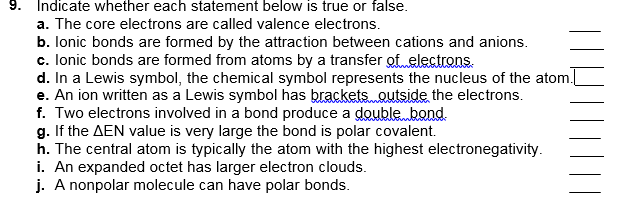a. The core electrons are called valence electrons. b. lonic bonds are formed by the attraction between cations and anions. c. lonic bonds are formed from atoms by a transfer oftelectrons. d. In a Lewis symbol, the chemical symbol represents the nucleus of the atom. e. An ion written as a Lewis symbol has brackets. outside the electrons. f. Two electrons involved in a bond produce a double bond. g. If the AEN value is very large the bond is polar covalent. h. The central atom is typically the atom with the highest electronegativity. i. An expanded octet has larger electron clouds. j. A nonpolar molecule can have polar bonds.
a. The core electrons are called valence electrons. b. lonic bonds are formed by the attraction between cations and anions. c. lonic bonds are formed from atoms by a transfer oftelectrons. d. In a Lewis symbol, the chemical symbol represents the nucleus of the atom. e. An ion written as a Lewis symbol has brackets. outside the electrons. f. Two electrons involved in a bond produce a double bond. g. If the AEN value is very large the bond is polar covalent. h. The central atom is typically the atom with the highest electronegativity. i. An expanded octet has larger electron clouds. j. A nonpolar molecule can have polar bonds.
ChapterU2: Smells: Molecular Structure And Properties
Section: Chapter Questions
Problem 3STP
Related questions
Question

Transcribed Image Text:9. Indicate whether each statement below is true or false.
a. The core electrons are called valence electrons.
b. lonic bonds are formed by the attraction between cations and anions.
c. lonic bonds are formed from atoms by a transfer ofelectrons.
d. In a Lewis symbol, the chemical symbol represents the nucleus of the atom.
e. An ion written as a Lewis symbol has brackets. outside the electrons.
f. Two electrons involved in a bond produce a doublebond.
g. If the AEN value is very large the bond is polar covalent.
h. The central atom is typically the atom with the highest electronegativity.
i. An expanded octet has larger electron clouds.
j. A nonpolar molecule can have polar bonds.

Transcribed Image Text:10. Write all alternative (total of six) Lewis structures of CISQ*. Calculate formal chargeson
each atom in each structure. Apply formal charge rules to select the most plausible
structure among all alternative structures. Justify your selection.
Expert Solution
This question has been solved!
Explore an expertly crafted, step-by-step solution for a thorough understanding of key concepts.
Step by step
Solved in 2 steps

Knowledge Booster
Learn more about
Need a deep-dive on the concept behind this application? Look no further. Learn more about this topic, chemistry and related others by exploring similar questions and additional content below.Recommended textbooks for you



Introductory Chemistry: A Foundation
Chemistry
ISBN:
9781337399425
Author:
Steven S. Zumdahl, Donald J. DeCoste
Publisher:
Cengage Learning



Introductory Chemistry: A Foundation
Chemistry
ISBN:
9781337399425
Author:
Steven S. Zumdahl, Donald J. DeCoste
Publisher:
Cengage Learning

Chemistry for Today: General, Organic, and Bioche…
Chemistry
ISBN:
9781305960060
Author:
Spencer L. Seager, Michael R. Slabaugh, Maren S. Hansen
Publisher:
Cengage Learning


Chemistry: The Molecular Science
Chemistry
ISBN:
9781285199047
Author:
John W. Moore, Conrad L. Stanitski
Publisher:
Cengage Learning